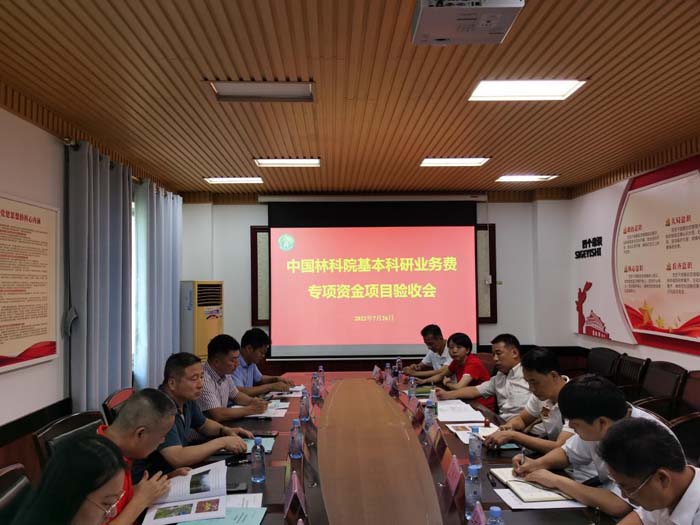
丛生竹林下竹荪富硒菌棒覆土栽培技术
编号
lyqk008906


中文标题
丛生竹林下竹荪富硒菌棒覆土栽培技术


作者单位
广东省森林培育与保护利用重点实验室/广东省林业科学研究院 广州 510520


期刊名称
世界竹藤通讯


年份
2021


卷号
19


期号
4


栏目名称
学术园地


中文摘要
在丛生竹林下对不同基质配方和硒浓度菌棒进行埋棒栽培以及覆土方式栽培试验,结果表明,菌棒不同基质配方对竹荪产量及其营养成分有显著影响,而且三列浅沟形和双列龟背形2种覆土方式有利于提高竹荪产量。改良基质配方菌棒竹荪产量比常规配方提高约50%;在添加外源硒质量分数为0~2.0 mg/kg的浓度范围内,竹荪子实体产量先随着硒浓度的增加而逐渐增加后再有所降低,基质中添加1.5 mg/kg硒肥比不添加产量提高了195.30%。基质中添加硒质量分数为1.0~2.0 mg/kg的硒肥可以较显著地提高竹荪花的硒含量,其干物质中硒含量平均值从约2.50 mg/kg提高到8.05~13.30 mg/kg,外源硒肥利用率达到9.70%~15.36%。菌棒不同基质配方对竹荪子实体的粗蛋白及粗多糖含量有明显影响,改良配方竹荪蛋与竹荪花的粗蛋白含量是常规配方的1.21和1.29倍,其粗多糖含量是常规配方的4.81和1.35倍;基质中添加硒肥与不添加硒肥相比,竹荪蛋与竹荪花中粗蛋白含量分别增加了40.90%和14.30%。在硒质量分数为1.0 mg/kg的竹荪菌棒林下覆土栽培试验中,三列浅沟形覆土方式单位面积鲜竹荪蛋产量最高,为10.27 kg/m2;双列龟背形覆土方式单个菌棒的鲜竹荪蛋产量最高,达1.40 kg。三列浅沟形和双列龟背形2种覆土方式基质生物转化率分别为93.00%和94.14%,达到了较高水平。


基金项目
广东省林业科技创新项目“竹林下富硒竹荪立体栽培技术研究”(2017KJCX008);广东省2019年度科技特派员凝炼项目“广东省林下竹荪栽培技术集成与推广”。


英文标题
Soil-covering Cultivation Technique of Selenium-enriched Dictyophora indusiate Spawn under Sympodial Bamboo Forest


作者英文名
Wang Yuxia, Liao Huanqin, Chen Xinyu, Pan Wen, Zhang Weihua, Xu Fang, Cao Guanghua


单位英文名
Guangdong Provincial Key Laboratory of Silviculture, Protection and Utilization/Guangdong Academy of Forestry, Guangzhou 510520, China


英文摘要
The soil-covering mushroom spawn cultivation and casing methods are experimented with different matrix formulas and different selenium content under sympodial bamboo forest. The results show that cultivation matrix has a significant effect on the yield and nutrients of Dictyophora indusiate, and two casing methods of three-line shallow grooves and double turtle-back shape are conducive to improving the yield of D. indusiate. The yield of improved matrix increases by about 50% compared with conventional matrix. The yield increases first with the increase of selenium concentration and then decreases when the content of added selenium falls in the range of 0-2.0 mg/kg. By adding 1.5 mg/kg selenium in matrix, the yield is 195.30% higher than that without selenium adding. Adding 1.0-2.0 mg/kg selenium in the matrix could significantly increase averagely the selenium content in D. indusiate flowers, under which the selenium content in dry mass could grow from 2.50 mg/kg to 8.05-13.30 mg/kg, and the utilization rate of added selenium fertilizer could be 9.70%-15.36%. Different cultivation matrix formulas have a significant effect on content of crude polysaccharide and crude protein in D. indusiate fruiting bodies. The crude protein content in D. indusiata eggs and flowers in the improved matrix is 1.21 and 1.29 times higher than those in conventional cultivation matrix, and the crude polysaccharide is 4.81 and 1.35 times higher. The crude protein content of D. indusiata eggs and flowers with selenium adding in matrix is 40.90% and 14.30% higher than those without selenium adding. The per-unit-area yield of fresh D. indusiata eggs is the highest if the casing method of three-line shallow grooves is used with the selenium content at 1.0 mg/kg, amounting to 10.27 kg/m2, while fresh D. indusiata eggs on a single spawn are the most with the casing method of double turtle-back shape, reaching 1.40 kg. The biotransformation rates of the two casing methods are 93.00% and 94.14%, respectively, which reach a higher level.


英文关键词
Dictyophora indusiata;understory cultivation;selenium-enriched mushroom spawn;casing method


起始页码
21


截止页码
27


作者简介
王裕霞(1966-),教授级高级工程师,主要从事竹类及食用菌富硒栽培与资源开发利用研究。E-mail:243737393@qq.com。


DOI
10.12168/sjzttx.2021.04.004


参考文献
[1] 郭成金. 蕈菌生物学[M]. 北京:科学出版社, 2015:232.
[2] 柯伙钊, 林玉满. 长裙竹荪菌体糖蛋白DiGP-2的组成分析和抑瘤作用的研究[J]. 海峡药学, 2001, 13(4):120-122.
[3] 林陈强, 林戎斌, 陈济琛, 等. 棘托竹荪菌盖提取物的抗氧化活性[J]. 食用菌学报, 2013, 20(2):32-36.
[4] 林海红, 林浪, 陈碧. 长裙竹荪对大鼠血脂的影响[J]. 福建农业大学学报(自然科学版), 2000, 29(2):238-241.
[5] 包金亮, 单斌凯, 张晓勉.竹荪栽培新法[J]. 食药用菌, 2018, 26(2):106-108.
[6] 兰云龙, 应国华. 红托竹荪栽培方式优选试验[J]. 浙江食用菌,1996(5):18.
[7] 应国华, 吕明亮, 李伶俐, 等. 低海拔竹林下红托竹荪菌棒式栽培技术研究[J]. 食用菌, 2015, 37(1):35-36.
[8] 王裕霞, 陈新宇, 徐斌, 等. 基质硒含量对棘托竹荪菌丝生长及其谷胱甘肽过氧化酶活性的影响[J]. 世界竹藤通讯, 2021, 19(1):20-23.
[9] 中华人民共和国质量监督检验检疫总局. 食用菌中粗蛋白含量的测定:GB 5009.5-2016[S]. 北京:中国标准出版社, 2009.
[10] 中华人民共和国质量监督检验检疫总局.食用菌中总糖含量的测定:GB/T 15672-2009[S]. 北京:中国标准出版社, 2009.
[11] 中华人民共和国国家卫生和计划生育委员会. 食品中多元素的测定:5009.268-2016[S]. 北京:中国标准出版社, 2009.
[12] 中华人民共和国国家卫生和计划生育委员会.食品中水分的测定:GB 5009.3-2016[S]. 北京:中国标准出版社, 2009.
[13] CORE R, STATISTICAL P, NUURDCT R. A language and environment for statistical computing[J]. Computing, 2014(1):12-21.
[14] 胡婷, 惠改芳, 赵桂慎, 等. 富硒食用菌研究进展[J]. 食用菌学报, 2019, 26(1):68-76.
[15] 刘书畅, 马布平, 周忠发, 等. 富硒食用菌的研究进展(综述)[J]. 食药用菌, 2018, 26(2):74-78.
[16] 曹素芳, 吴法先, 李学锋, 等. 提高食用菌中硒含量的研究[J]. 中国食用菌, 1992(5):10-12.
[17] 魏云辉, 魏小桃, 邓王君, 等. 猴头菌富硒栽培试验[J]. 江西农业科技, 2004(12):22-23.
[18] 陈石良, 许正宏, 孙微, 等. 灰树花富硒培养研究[J]. 食用菌学报, 2000, 7(1):27-31.
[19] 闫靖华, 周振祥. 黑木耳富硒栽培试验[J]. 食用菌, 2020, 42(1):43-44.
[20] 梁英, 杨宏志. 黑木耳富硒栽培研究[J]. 食用菌学报, 2000, 7(4):34-37.
[21] 梁英, 高彦斌, 陈丽红, 等. 香菇富硒栽培的研究[J]. 食用菌, 2000(1):5-7.
[22] 胡国元, 李伟伟, 王耀军. 富硒金针菇菌丝多糖的初步研究[J]. 食用菌学报, 2000, 7(2):11-14.
[23] 赵镭, 赵振东, 陈鹏, 等. 生物富硒对灵芝营养成分的影响[J]. 西北植物学报, 2004, 24(7):1275-1280.


PDF全文
浏览全文


-
相关记录
更多
- 贵州赤水楠竹林菌笋复合经营技术 2022
- 高寒阴湿区皮胎果林下羊肚菌栽培技术 2021
- 竹荪的采摘、烘干及贮藏技术 2020
- 浙江诸暨毛竹林下仿野生竹荪栽培试验 2018
- 冷凉灌区双孢蘑菇覆土改良技术研究 2018
- 竹林套种竹荪生态栽培技术研究与效益评价 2017
 打印
打印
